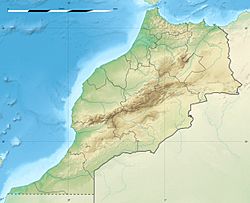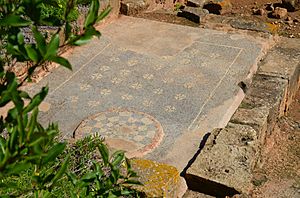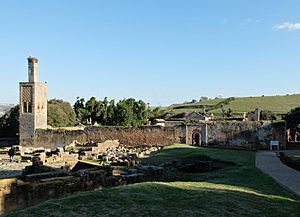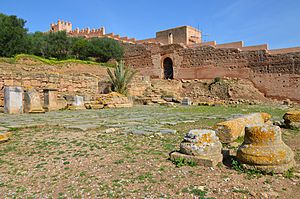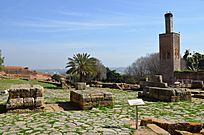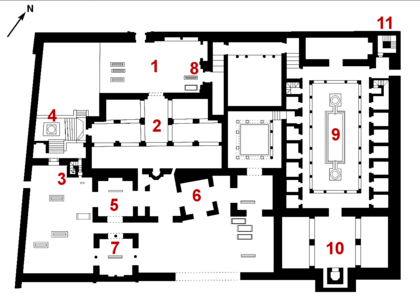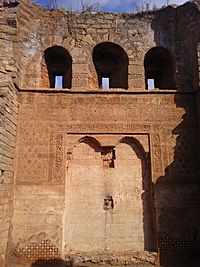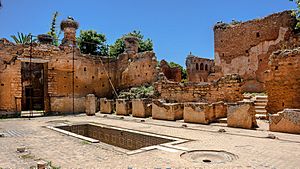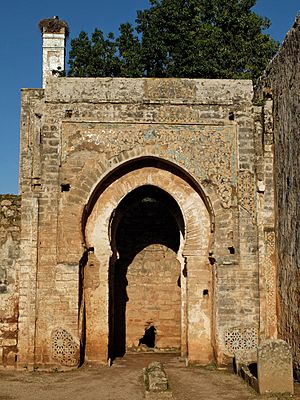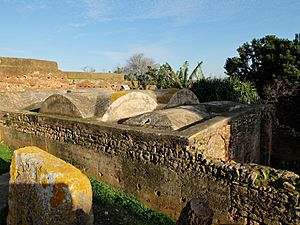Chellah facts for kids
|
Sla / Calla (Shalla)
|
|

Roman and Marinid remains inside the Chellah complex
|
|
| Alternative name | Sala Colonia (name of Roman colony) |
|---|---|
| Location | Rabat, Rabat-Salé-Kénitra, Morocco |
| Coordinates | 34°00′24″N 06°49′13″W / 34.00667°N 6.82028°W |
| Type | Necropolis |
| History | |
| Abandoned | early 15th century |
The Chellah or Shalla (Berber languages: Sla or Calla; Arabic: شالة) is a very old place in Rabat, Morocco. It used to be a busy trading port and later a Roman colony. Then, it became a special burial ground for a powerful Muslim family called the Marinids.
This amazing site is located on the south side of the Bou Regreg river. People believe that Phoenicians, who were ancient traders, might have set up a trading post here thousands of years ago. Later, the Romans built a city called Sala Colonia. After a long time, the Marinid sultans turned part of the site into a royal necropolis (a large cemetery). They built beautiful religious buildings there.
Over the centuries, Chellah faced damage from earthquakes and people looking for treasures. But in the 1900s, archaeologists started digging and found the remains of the old Roman town. Today, Chellah is a popular place for tourists. Since 2012, it is part of a UNESCO World Heritage Site, which means it's recognized as very important globally.
Contents
Discovering Chellah's Past
Who Lived Here First? Phoenicians and Berbers
Historians think that the Phoenicians, who were great sailors and traders from ancient times, might have had a small trading post here around 300 BC. They found some old Phoenician pottery pieces. However, it's not totally clear if they lived here or just traded goods.
The local people called their settlement "Shalat," which means "rock." Before the Romans arrived, the area was part of the ancient Berber kingdom of Mauretania.
The Romans Arrive: Building Sala Colonia
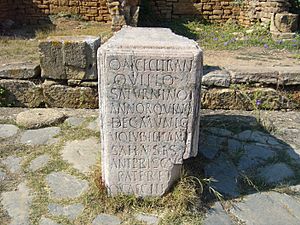
Around the 1st century BC, the powerful Roman Empire started to influence this region. The Mauretanian kingdom became a "client state" of Rome, meaning it was friendly with Rome but still had its own rulers. Some items from these kings have been found at Chellah.
In 40 AD, Rome took full control and built their own city called Sala Colonia on this site. It was a busy port city with important Roman buildings. Archaeologists have found parts of a main road (called a decumanus maximus), a public square (a forum), and a triumphal arch. Sala Colonia was an important city and port for the Romans in this part of Africa.
Even after the Roman soldiers left in the 4th century, Sala Colonia still had some connections with the Roman Empire. They found items from other parts of Europe, showing that trade continued. Some pottery with Christian symbols was also found, showing that Christianity was present here between the 4th and 6th centuries.
The Early Muslim Era: A New Beginning
Sala Colonia slowly became empty in the 5th century. When Muslim Arabs arrived in the 7th century, most of it was already in ruins. The area was settled again in the 10th century.
Around 1030, a new town called Salā (which is modern-day Salé) was built on the other side of the river. Later, the Almoravids and then the Almohads, two powerful Muslim dynasties, built forts and cities nearby. The Almohad leader, Abu Yusuf Ya'qub al-Mansur, even started building a huge new royal city next to ancient Sala, but it was never finished.
The Marinid Period: A Royal Burial Ground
During the Marinid dynasty (from the 13th to 15th centuries), the old Roman site of Sala was given a new purpose. It became a royal burial ground, and this is when it got its current name, Chellah.
The first Marinid ruler to be buried here was Sultan Abu Yusuf Ya'qub in 1286. He built a small mosque and a special tomb for his wife. Other Marinid sultans and their families were also buried here.
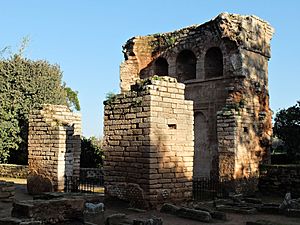
The most important Marinid buildings were added during the time of Sultan Abu Sa'id Uthman II and his son, Abu al-Hasan (also known as the Black Sultan). Abu Sa'id built strong walls around the area and started the main gate. His son, Abu al-Hasan, finished the main gate in 1339. He also built a beautiful madrasa (an Islamic school) and a tall minaret (tower) next to the mosque and tombs.
Abu al-Hasan was the last sultan to be buried at Chellah. After him, other Marinid rulers were buried in different cities. However, some other Marinid family members were still buried here.
Chellah After the Marinids: Decline and Rediscovery
After the Marinid period, Chellah was not as important. It was robbed several times, and many buildings were damaged by the big 1755 Lisbon earthquake.
Even though it was in ruins, Chellah became a special religious place for local people. Some Sufis (Muslim mystics) lived there, and the old madrasa was used as a religious center. People believed that visiting Chellah could be like a smaller version of the Hajj pilgrimage to Mecca. They also believed that feeding the eels and turtles in the pools could bring good luck, especially for women hoping to have children.
In the late 1800s, French explorers first recognized the remains of the ancient Roman city. Later, in the 1920s and 1950s, archaeologists started serious excavations. They cleared away plants and uncovered the Roman buildings we can see today.
Today, Chellah is a peaceful garden and a popular place to visit. It's also famous for its large colony of storks, which build their nests on the old minaret and in the trees.
Exploring the Roman Ruins
The part of the Roman city that has been dug up covers about 1.2 hectares (around 3 acres). This area was the main public district, where the most important buildings stood. The city was built on a slope, so buildings were placed on different levels or terraces. The streets were laid out in a neat grid pattern.
At the eastern end, you can see the forum, which was the main public square. On one side of the forum, there are remains of a temple. On the other side, there's a long building with nine rooms, which might have been shops.
The largest building here is the capitolium or capitoline temple. This temple was built on two levels. The lower level had nine vaulted rooms that were probably shops. The upper level was the temple itself, with a main room and a front porch, raised on a platform. It was surrounded by 32 columns. This temple was built around 120 AD.
Near the capitolium, you can also see the remains of a triumphal arch. Only the base of the arch is left, so we don't know much about its original appearance. There are also other smaller temples and the remains of a Roman bathhouse in the eastern part of the site.
The Marinid Necropolis: A Royal Cemetery
The Marinid walls surround an area that is smaller than the old Roman city. Most of the Marinid buildings are part of a religious complex in the southeastern part, called the khalwa. There's also a bathhouse and a residential area near the main gate.
The khalwa includes a mosque, a madrasa (school), a cemetery with several tombs, and courtyards. There's also a pool that gets its water from a natural spring. This pool was originally used for washing before prayers, but now it's home to eels!
Strong Walls and a Grand Gate
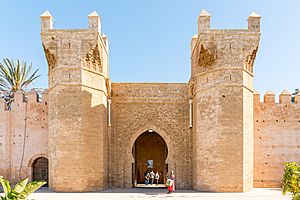
The walls around Chellah are made of rammed earth, a traditional building material. They have three gates and many defensive towers. The most impressive gate is in the northwestern part. It's made of brick and carved stone with beautiful decorations.
The gate has two fancy arches and its sides are filled with detailed plant-like patterns. There's also an Arabic inscription that tells us when the gate was built. The gate is flanked by two towers. Inside, the passage turns 90 degrees, which was a common defensive design.
The Religious and Burial Complex
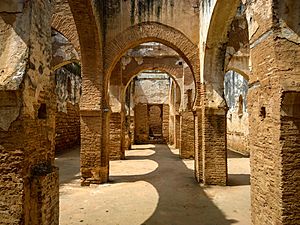
The mosque is in the center of the complex. It has a large prayer hall with rows of arches. In one corner, there's a small, partly ruined minaret. Outside the mosque, there's a small well for washing.
Behind the mosque, there's a garden cemetery with several ruined tombs. These include the tombs of Sultan Abu Sa'id and Shams al-Ḍuḥa. Each tomb was a square room, probably covered by a dome or a pyramid-shaped roof.
The tomb of Sultan Abu al-Hasan is the most decorated and best-preserved. Its walls are covered with amazing stone carvings. Inside, there's a special niche with Arabic writing from the Qur'an and geometric patterns. The outside of the tomb also has beautiful carvings and inscriptions.
Most of the complex's northeastern half is taken up by a building that was likely a madrasa (Islamic school). It has a long rectangular courtyard with a pool in the middle. Small rooms around the courtyard were probably for students. At one end of the courtyard, there's a prayer room with a special niche called a mihrab.
A tall minaret, about 15 meters (50 feet) high, stands at the madrasa's corner. Its four sides are decorated with special patterns and colorful tilework called zellij.
Another beautiful part of the complex is the gateway leading to the madrasa. It's a horseshoe arch framed by colorful zellij tilework with geometric star patterns. The decoration on this gate is very similar to another famous complex in Algeria, suggesting the same skilled artists might have worked on both.
The Marinid Bathhouse
Chellah also has a hammam, which is an Islamic bathhouse. It was built around the same time as the other main Marinid buildings. It has different rooms for changing, cold baths, warm baths, and hot baths, just like ancient Roman baths. A furnace heated the water and the floors using a system called hypocaust. The bathhouse was restored in the 20th century.
Ancient Treasures Found Here
Many artifacts from Chellah are now kept in the Museum of History and Civilizations in Rabat. These include Roman-era items from Sala Colonia and Marinid-period pieces from the necropolis.
One interesting artifact is the tombstone of Sultan Abu Ya'qub Yusuf. It's a marble slab that was originally a Roman stone from Spain, with a Roman inscription on one side. It was later reused for a fountain in Spain and then brought to Morocco, where the Marinids carved the sultan's burial inscription on the other side. The museum also has the richly carved marble tombstones of Sultan Abu al-Hasan and his wife.
Chellah as a Music Venue
Since 2005, the beautiful ruins of Chellah have become a special place for music. They host an international "Festival of Jazz" each year, called Jazz au Chellah. It's also one of the venues for the annual Mawazine music festival in Rabat, which features popular music from all over the world.
See also
 In Spanish: Necrópolis de Chellah para niños
In Spanish: Necrópolis de Chellah para niños
- Volubilis
Images for kids
-
Roman funerary stele inscribed in Latin, Sala Colonia
-
Remains of the Mausoleum of Abu al-Hasan (circa 1351)
-
Qubba mausoleums of local saints, dating from later periods, near the Marinid complex
-
Remains of the foundations of the triumphal arch
-
The main gate of Chellah, completed in 1339 by Abu al-Hasan
-
The mosque of the Marinid complex (built circa 1284)


